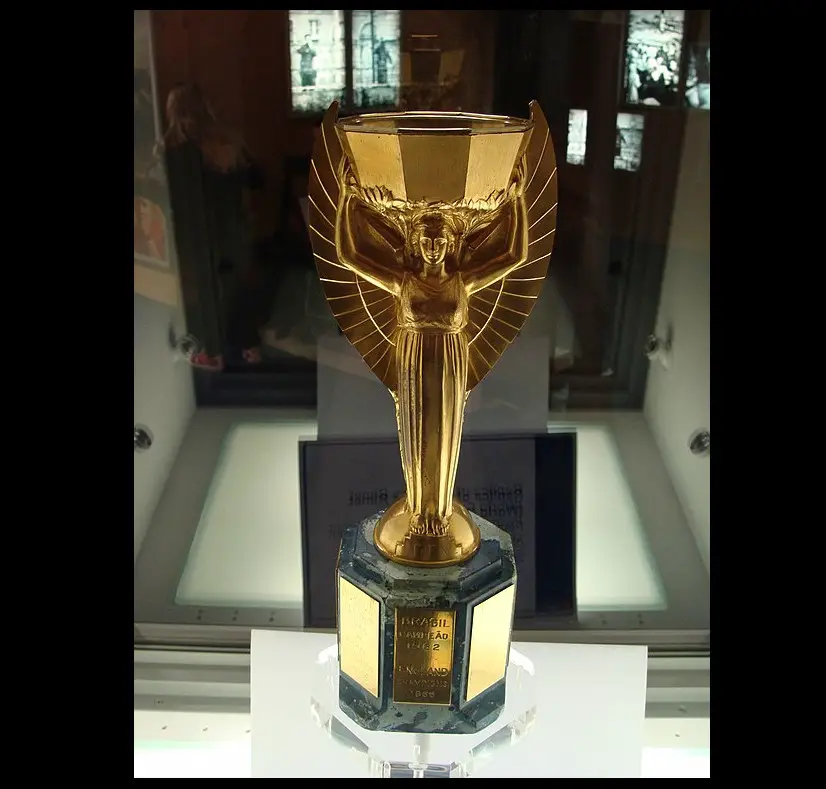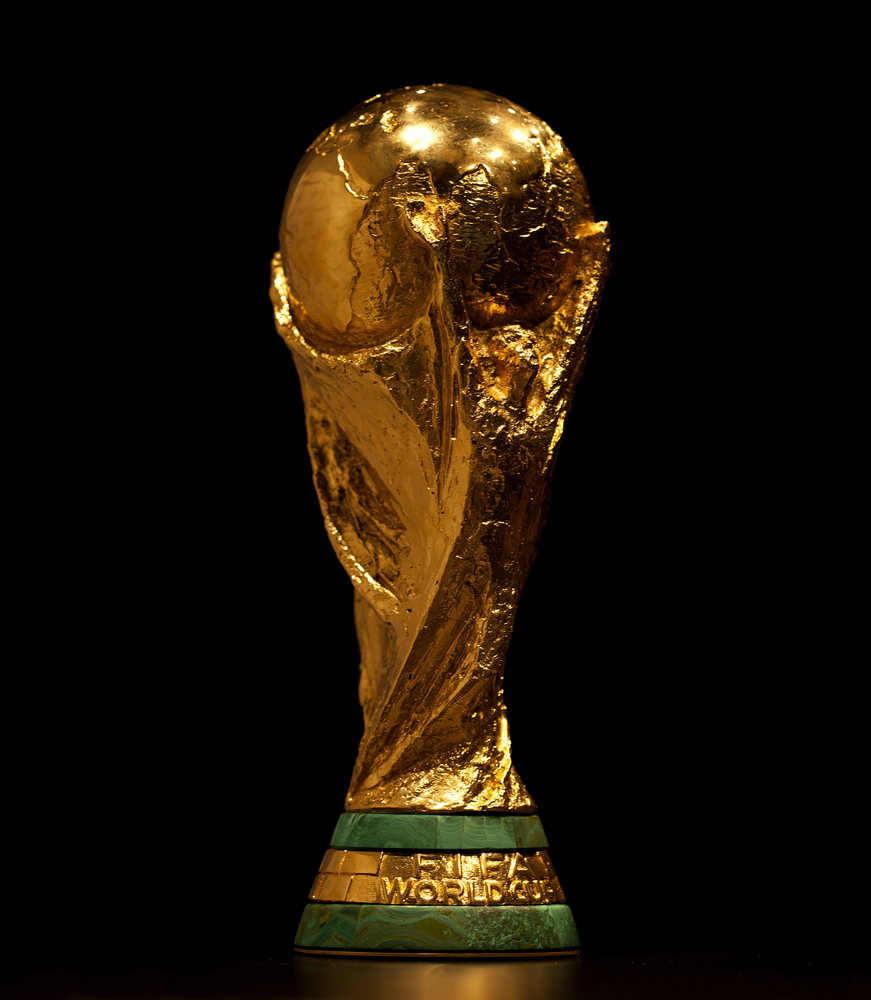
The FIFA World Cup Trophy is one of the most coveted and expensive trophies in sports. It is made of 18-karat gold and valued at $250,000. But the winning team of the World Cup doesn’t get to keep the trophy, and players get medals instead for first, second, and third place. FIFA keeps a tight leash on the World Cup trophy and for a good reason. The original trophy was stolen and found by a dog in 1966, and it was stolen again in 1983, never to be seen again.
The Theft in 1966
In 1966, England was hosting the World Cup, and the trophy was put on display at Central Hall Westminster in London four months before the first game. The trophy was known as the Jules Rimet trophy at the time, named after the man who had started the World Cup, and it depicted Nike, the Greek goddess of victory, holding a cup.
On March 20, 1966, a day after the start of the exhibition of the trophy, it disappeared. No one knew how it happened. News spread worldwide quickly, and Scotland Yard began to investigate, though they had few to any leads to go on. About the only thing was a sighting of a suspicious man that left the hall prior to the trophy being stolen.
The next day, Joe Mears, the chairman of the Football Association, the governing body for the sport in England, got a package that contained the lining from the top of the trophy along with a ransom note for £15,000. The note was signed only with the name “Jackson.” “Jackson” threatened to melt down the trophy if Mears involved the police or journalists. It read: “Dear Joe Kno [sic] doubt you view with very much concern the loss of the world cup… To me it is only so much scrap gold. If I don’t hear from you by Thursday or Friday at the latest I assume it’s one for the POT.”
Mears called “Jackson” to exchange the money for the trophy, but he had also informed Scotland Yard, who made a briefcase of fake bills. They also intended to have undercover agents with Mears, but before he was to make the exchange, Mears had a heart attack and was confined to his bed. It was then arranged that Mears’s assistant, McPhee, who was actually an undercover detective inspector named Len Buggy, would complete the exchange.
McPhee showed up for the meeting as did “Jackson,” who incidentally didn’t fit the description of the man the police had of leaving the hall after the trophy had been stolen. McPhee showed him the money, but “Jackson” said he didn’t have the trophy with him and said, “You will have to trust me and come with me for about a 10-minute drive, where I can pick up the cup.”
The two left in McPhee’s car with McPhee driving, but “Jackson” got nervous when he noticed a van following them. He thought it was the police and bailed from the moving car. McPhee chased after the man and arrested him.
“Jackson” turned out to be a petty thief with a rap sheet named Edward Betchley. He insisted that he didn’t steal the cup and had been given £500 to act as an intermediary for someone he called “the Pole.” After hearing the news and fearing that the trophy would never be recovered, the Football Association had a replica trophy made secretly.
Scotland Yard had no more credible leads, but on March 27, a man named David Corbett was walking his dog Pickles in South London. Pickles was sniffing around on the ground when Corbett saw him near a package wrapped in newspaper. When Corbett uncovered it, he realized it was the World Cup.
The trophy was returned to the Football Association, and Pickles the dog and Corbett achieved worldwide notoriety, though the man ended up on the suspects’ list for a few weeks before being cleared. England ended up winning the World Cup that year, its only time to date, but no one was ever arrested for the theft of the trophy or knew who might have taken it. But new information came to light in 2017 that unraveled who might have been behind the theft.
The crime editor at the Mirror, Tom Pettifor, who made a documentary called 1966: Who Stole The World Cup?, was told by a contact in 2017 that he knew who had taken the trophy in 1966. He was told the thief’s name was “Sidney Kew” and he was from the “Walworth Road area,” an area in South London known for being rough in the 60s.
Pettifor looked over police files from 1966 and found that Betchley, who had said he was the supposed intermediary between the thief and police, had been arrested near the Walworth area. Pettifor eventually found that “Sidney Kew” was a man named Sidney Cugullere.
Cugullere had been a thief and jailed for much of his adult life, and he fit the original description of the man who had been leaving the hall at the time of the trophy’s disappearance. Pettifor contacted Cugullere’s nephew, who confirmed that the man had stolen the World Cup in 1966 but had died a few years earlier. The fact that he had stolen the trophy was known by his family and friends, and even at his funeral, there was a wreath made to resemble the World Cup trophy.
Pettifor was told that Cugullere had not initially gone to the hall to steal the trophy and was there to case the collection of stamps held in the basement worth millions of dollars. Stamps were a popular item to steal in the 1960s. Cugullere had found a way into the locked exhibition hall and saw that the trophy was easier to steal as it was by itself, and no guards were around. He supposedly put it under his jacket and walked out of the hall.
Since Cugullere hadn’t intended to steal the trophy, he had no plan set up to sell the trophy. After Betchley was arrested, he was given only two years of jail time, when a much harsher sentence was usually imposed at the time. Some speculated that Cugullere had made a deal with the police to get the trophy back. How it ended up where Pickles the dog found it was never revealed.
The Second Theft of the Trophy
But this hasn’t been the only time the trophy has been stolen. It was stolen again in 1983 in Brazil. The Brazilian national team won the World Cup for the third time in 1970 and was given the trophy permanently. It was kept in the Football Confederation offices.
But thieves stole the trophy for the Football Confederation office, and it was never seen again. The trophy was believed to be melted down into gold bars, but since it was only plated in gold, this didn’t make much sense. An alternate theory is that it wound up in the hands of a nefarious collector and that it remains somewhere in this person’s private collection. Only time will tell if it someday makes an appearance, possibly after the collector dies if this is indeed what happened to the trophy.
Since Brazil kept the trophy in 1970, a new trophy design was commissioned after the tournament held in Germany. FIFA held a competition and received 53 submissions from around the world. The winner was the design by an Italian named Silvio Gazzaniga. A new World Cup trophy will be needed in 2042 since the name plaque at the base was designed only for the names of 17 champions from 1974 to 2038.
Sources: The Washington Post, CBC, FIFA, The Athletic


